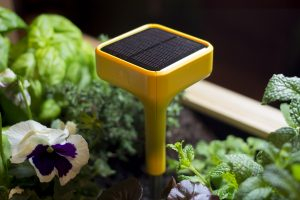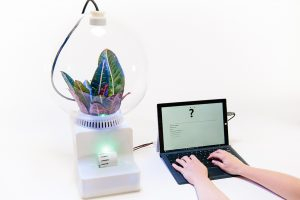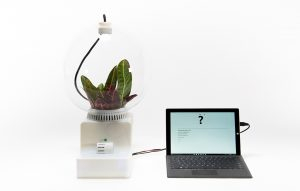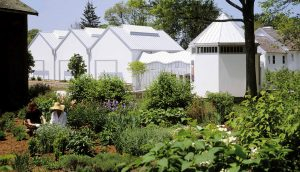
 Data Structure
Data Structure Networking
Networking RDBMS
RDBMS Operating System
Operating System Java
Java MS Excel
MS Excel iOS
iOS HTML
HTML CSS
CSS Android
Android Python
Python C Programming
C Programming C++
C++ C#
C# MongoDB
MongoDB MySQL
MySQL Javascript
Javascript PHP
PHP
- Selected Reading
- UPSC IAS Exams Notes
- Developer's Best Practices
- Questions and Answers
- Effective Resume Writing
- HR Interview Questions
- Computer Glossary
- Who is Who
Project Florence Enabling Gardeners to know what plants “SPEAK”?
Plants are important to make a sense of balance between nature and in people’s lives. Being living organisms, they have a place in the vegetable kingdom that can live on land or in water. Plants and humans are mutually dependent for life and sustainability but are unable to share emotional bonds of each other.

However, can you imagine that plants can even speak and feel the emotions of a human being? Yes, it is not just the imagination now. It can be possible. The gardeners can understand the thought of plants and can talk to them scientifically through a great research, known as “Project Florence”.
Creation of Project Florence
The project is simply a great discovery under the umbrella of Microsoft Research’s Studio99 program. This program is specially designed to encourage teamwork between researchers/engineers and artists/ creators to generate innovative practices that motivate better approaches for considering existing and future technical challenges.
This is accomplished through their Artist in Residency program, in which Helene Steiner took an interest. The project Florence has been possible with the help of Natural Language Processing, Human-computer Interaction, Engineering, and Biology groups, all stimulated by the thought of making new discourse with the natural world.
Describing Project Florence
Nature has its own language of communication and Project Florence helps us in a deep understanding that. Gardeners have a strong conviction that plants respond when they talk to them and even plants can grow better through this. The communication of our natural surroundings is constantly fascinated, researchers.
Many reviews on this ground have clearly demonstrated that plants discharge volatile organic chemical (VOC) when they are in pain to other plants in a bioinformatics way. In return, the other plants also start to transmit a similar VOC. It is a romantic concept through which they can continue to flourish.
Communication Between Human and Nature
This lovely display of communication is the fact that motivated Helene Seiner to start Project Florence, and at Microsoft Research, she adopted a more creative strategy to crossing over innovation and nature. On account of Project Florence, it has been proven that plants can interact with each other. Redmond, a WA-based Microsoft Research, has been building up a route for people to join the discussion beyond eavesdrop.

Just like “Project Florence”, there are multiple other parallels running projects too.
But, this one has been made as a result of a complete dedication of post-doc researchers of Helene Steiner, throughout her time as an artist-in-residence with Microsoft Research’s Studio 99 program. She has proved the potential of project Florence by generating a fresh insight on how we can get in contact with our natural surroundings.
Use of Electrical Pulses to Communicate
Steiner dedicated a greater part of her concentration to Florence a year ago and now it is completely possible that you can converse to the plants in your garden in a dialect of electrical impulses and chemicals. The resulting conversations in which the distinctive plants have participated are somewhat mysterious but astonishingly poetic.
The project depicts you the way to have a chat with the plants. The main concept of this project is the inter-connectivity between a sensor-loaded plant capsule and a PC, through which one can send a message to the plants and consequently, can expect a reply from them in return as well. Therefore, it is now believed that Project Florence can be a mediator between the natural habitat and our mechanical world.
Not only that, Project Florence says how plants receive the emotion from different light frequencies and utilize it to enact electrical reactions. A comparison is made between plant signs and natural language procedures occurred. This is, of course, a great discovery which advances plants as fast living subject and makes a fundamental discussion with our common habitat.
Working Procedure of Project Florence
Project Florence technology revolves around a sensor-equipped capsule, which is connected to a companion computer. When you begin to communicate under project Florence, you can type anything that you like on device’s accompanying terminal that is associated with the plant system post which your typed messages are sent to a cloud service hosted in Azure.

All sentence structures get scrutinized through a Natural Language Processing by the cloud service. It is then converted into stimuli, just like a colored light. To summarize, when you write a message, it is mapped for sentiments, irrespective of being positive or negative. These sentiments are turned into a Morse Code-like sequence of blinks that a plant can comprehend to reply.
For instance, a warm, kind sentiment may show up as long red blinks, as it grounds a plant to flower. On this way, plants react to various light frequencies as a way to convey diverse sentiment and trigger a plant’s reaction. There are different types of environmental sensors that are used in Florence, for instance, soil moisture, humidity, air temperature and atmospheric conditions, electrical reaction sensors etc.
Hooking the Device Up
The device connected onto the leaves or stems of the plant. The sensors are constantly observed to follow the changes to a plant’s environment. The signs included with linguistic input are utilized to make a reaction from the plant. The subsequent reactions are changed in the input and get driven by linguistic trees and lexical paraphrases. After the above process, Florence responses back with sentences through same Azure cloud channel.
It replies back utilizing the test words gathered from Twitter which is of a comparable context to your message. The sentiments are totally depended on the sensor readings, thus they get influenced by their mood and the time of the day. This entire conversion process is then conveyed through a little printer present at the base of the plant.
Different Plants have different reactions to Express
In general, there is no specific language for different plants to interact. But, they do use electro-chemical signals to response and set off processes inside themselves. In fact, each species can response in a different way to stimuli and adapt in their own way to its own desires. For example, few plants make bitters to defend, while others like Mimosa shrink away from physical touch.
The potential ability of project Florence
However, there are lots to be explored in the plant communication filed, including the unpredictability of various “languages” in nature and this can be possible only with the help of the new sensor technologies that would motivate others to comprehend these communication designs.

This communicating chance with our natural surroundings creates the capacity to look beyond the physical properties of plants. This could prompt novel applications of agriculture field to recognize things like plant invasion at a primary stage that requires fewer pesticides. We can enhance the responding process of nature and can change the environment by watching plants adjusting to their condition.
Value for Money and Efforts
This project can be valuable for everyone and can bring chances to gather knowledge and making engagement with the plants, which is very necessary for an urban environment and urban gardening. Florence is quite recently the principal occurrence of interfacing with nature.
It simply delivers a base for future research and applications for ecological reviews, organic sensors, and gen-expressions. Even, Microsoft is very serious and trying to explore more about this idea of discussion between plants and people.
Now, that project Florence has turned into a vital subject among several Microsoft divisions, even Microsoft is planning to proceed on researching more on this topic. Furthermore, Steiner will team up and will work closely with other academic researchers from Microsoft to additionally investigate the core science behind the technology and to expand the project precisely.
They all hope for the best with this broad research, the group can all the more precisely interpret a plant’s chemical and electrical output to better serve the plant itself. It would make easier to better comprehend a plant’s impulses.

